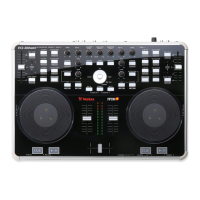
Do you have a question about the Vestax ITCH VCI-300MKII and is the answer not in the manual?
| Type | DJ Controller |
|---|---|
| Compatibility | Serato ITCH |
| Number of Channels | 2 |
| Connectivity | USB |
| Included Software | Serato ITCH |
| Pitch Control | Yes |
| EQ | 3-band |
| Faders | 2 |
| Power | USB bus-powered |
| MIDI | MIDI-compatible |
| Effects | Yes |
Lists minimum hardware and OS requirements for ITCH.
Step-by-step guide for installing the ITCH software.
Explains USB connection for power and data transfer.
Describes main output connections for sound systems.
Details headphone output and volume control.
Explains the different components of the main ITCH interface.
Details the functions of the various buttons, knobs, and sliders on the top panel.
Details the functions of front and rear panel ports like MIC IN, AUX IN, MASTER OUT.
Explains various methods to add music files to the library.
How to integrate and use your iTunes library within ITCH.
Importance and process of analyzing music files for corruption and waveform.
Automatically calculates and sets track BPM during analysis.
How to quickly find tracks using the search function.
Using the browse panel to filter tracks by criteria like genre or artist.
Methods to load tracks onto virtual decks using hardware or keyboard.
How to start, pause, and resume track playback using the controller.
Using TRIM knobs for track volume adjustment before mixing.
Using EQ controls for frequency adjustment and sound balancing.
Maintaining the original pitch of a track during tempo changes.
Visual representation of the deck showing track progress and status.
Details shown for loaded tracks including name, artist, and time.
Visual aid for beat matching by showing track tempos.
Setting unsaved cue points for temporary use during mixing.
Creating automatic loops based on track BPM and beat grids.
Adjusting track tempo and pitch to match for seamless mixing.
Automatically matching the tempo of one track to another.
Automatically aligning track beats for synchronized playback.
Creating and managing track collections for quick access.
Editing track metadata (ID3 tags) for better library management.
Exporting session information as text, CSV, or m3u playlists.
Controlling microphone and auxiliary inputs and their routing.
Capturing mix output, mic, or aux input recordings.
Configuring hardware settings like firmware and USB buffer size.
Customizing playback behavior, such as start points and key lock.
Settings for managing the music library, including iTunes integration.
Adjusting screen refresh rate and waveform display.
Information on Serato's Whitelabel Delivery Network for promotional releases.
Where to find software updates and online help resources.